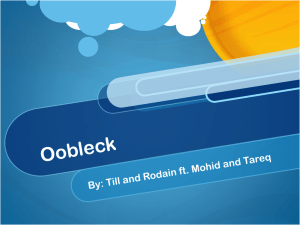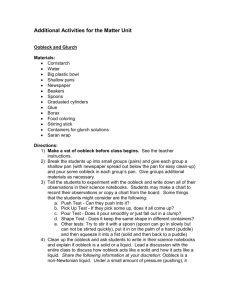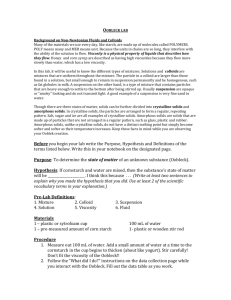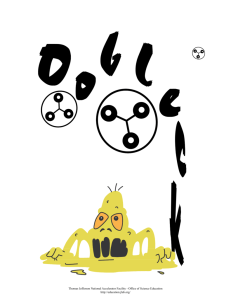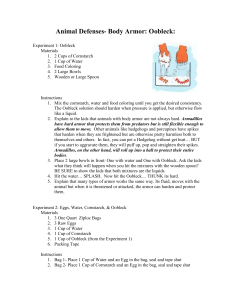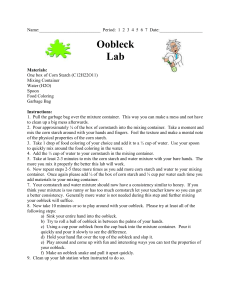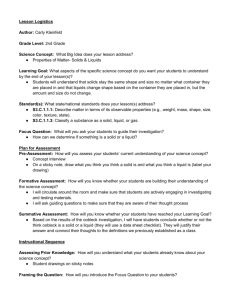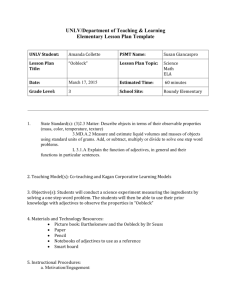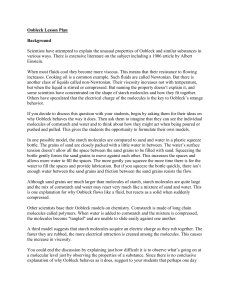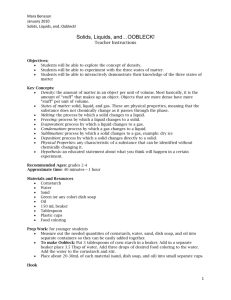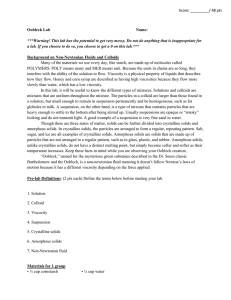Oobleck: a non-Newtonian Fluid
advertisement
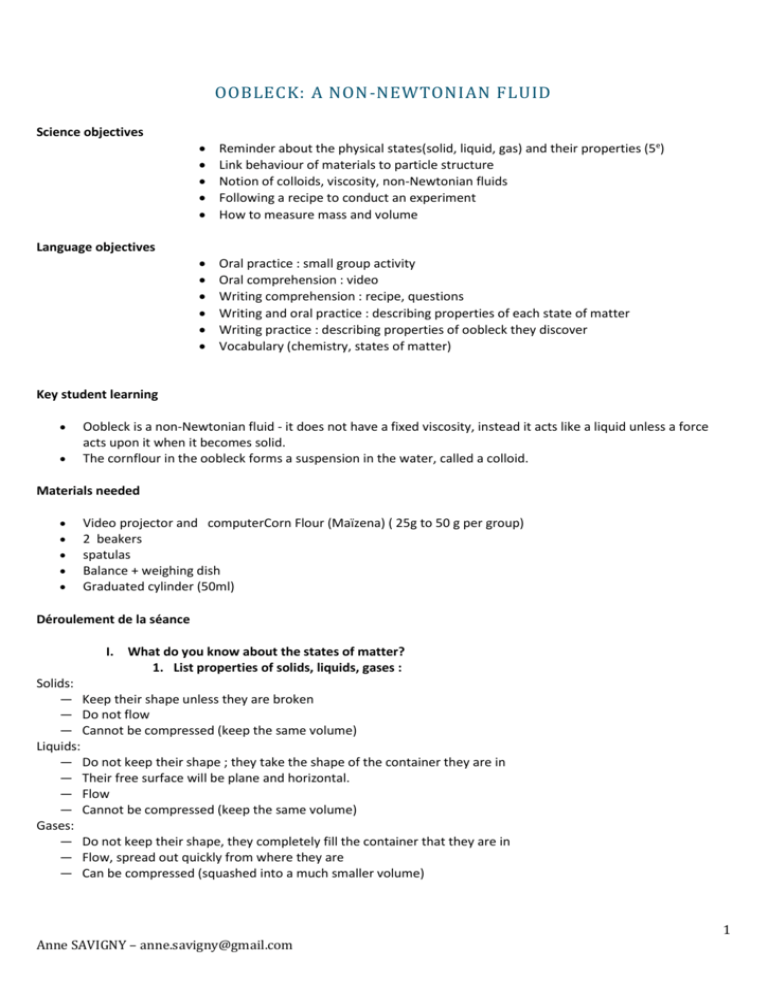
OOBLECK: A NON-NEWTONIAN FLUID Science objectives Reminder about the physical states(solid, liquid, gas) and their properties (5e) Link behaviour of materials to particle structure Notion of colloids, viscosity, non-Newtonian fluids Following a recipe to conduct an experiment How to measure mass and volume Oral practice : small group activity Oral comprehension : video Writing comprehension : recipe, questions Writing and oral practice : describing properties of each state of matter Writing practice : describing properties of oobleck they discover Vocabulary (chemistry, states of matter) Language objectives Key student learning Oobleck is a non-Newtonian fluid - it does not have a fixed viscosity, instead it acts like a liquid unless a force acts upon it when it becomes solid. The cornflour in the oobleck forms a suspension in the water, called a colloid. Materials needed Video projector and computerCorn Flour (Maïzena) ( 25g to 50 g per group) 2 beakers spatulas Balance + weighing dish Graduated cylinder (50ml) Déroulement de la séance I. What do you know about the states of matter? 1. List properties of solids, liquids, gases : Solids: — Keep their shape unless they are broken — Do not flow — Cannot be compressed (keep the same volume) Liquids: — Do not keep their shape ; they take the shape of the container they are in — Their free surface will be plane and horizontal. — Flow — Cannot be compressed (keep the same volume) Gases: — Do not keep their shape, they completely fill the container that they are in — Flow, spread out quickly from where they are — Can be compressed (squashed into a much smaller volume) Anne SAVIGNY – anne.savigny@gmail.com 1 (Trace au tableau + correction sur fiche ou sur cahier) 2. Do you think those are solids, liquids or gases? — — — — — — Ice Water Flour Honey Carbon Dioxide Snow II. Preparing some oobleck 1. Find your words You will find on your table everything you’ll need to prepare this mysterious thing “Oobleck”. But what are the names for all these things? Match each object with its name. (Noms écrits sur des papiers/post-it, matériel “en vrai”.) Graduated cylinder 2 beakers (1 big, 1 small) Weighing dish Balance Spatula Trace écrite : schéma avec noms à compléter. Graduated Cylinder Beaker Balance and weighing dish Spatulas 2. Lab techniques How can you measure a volume with a graduated cylinder? How can you measure a mass with a balance and a weighing dish? (Le professeur montre au bureau, ou avec un diaporama. Mesures de volumes, rappel de la technique pour les masses. Pop-quizz : on montre des éprouvettes, les élèves doivent lire les volumes). 3. Preparing Oobleck Pour some tap water in your small beaker. Measure 20 mL of this water with the graduated cylinder. Weigh 25 G corn flour. Put it in your big beaker. Pour your 20 mL water in the big beaker too. Stir gently and slowly with a spatula to mix it. Anne SAVIGNY – anne.savigny@gmail.com 2 Investigating Experiment with the Oobleck. Record your observations about the properties of Oobleck on your copybook. For each observation decide whether it is a solid, liquid or gas property and write a S, a L or a G in the margin according to what you decided. Answer the question: Is Oobleck a solid, a liquid or a gas? Discussio What is happening? How can we decide if Oobleck is solid or liquid? Can it be both? Some answers Watch the video (3:36) Maïzena : Newtons Nemesis film - Educators - Science Museum Discussion 2 Questions How can you explain viscosity? What happens with the viscosity of Oobleck? What could one use the Oobleck for? (protective clothing e.g.) Sound! REMARQUES, COMPLÉMEN TS Oobleck is a word that was used by Dr Seuss’s children. Dr Seuus is the author of the novel Bartholomew and the Oobleck, made as a film two years ago under the title Horton Hears a Who. Now it is commonly used to describe the sloppy goo made when corn flour and water are mixed, as in this experiment. More information on the Science Museum website (other fluids that change viscosity): www.sciencemuseum.org.uk/educators/classroom_and_homework_resources/resources/newtons_nemesis.aspx Plus d’explications sur le phénomène (explications, aspect microscopiques) (en français) : www.planetseed.com/fr/node/41198 On peut également montrer aux élèves une ou plusieurs vidéos de personnes marchant (ou courant) sur ce fluide. YouTube et une recherche de type “walking on Oobleck” donne de très nombreux résultats ! Anne SAVIGNY – anne.savigny@gmail.com 3
